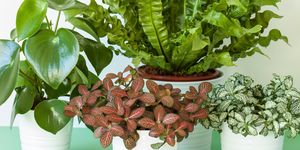Add that just-picked taste to your meals — even when snow is drifting up against the kitchen window — by growing herbs indoors all year long. You won’t even need special any special equipment as long as you give them plenty of water and sunshine.
How to Grow Herbs
As a general rule of (green) thumb, place your herbs in a spot that gets at least six hours of sun daily. To test the strength of sun, Bonnie Plants suggests that you turn off all lights on a sunny or partly sunny day, and periodically check to see how natural sunlight there is.
In addition to sunlight, all herbs need to be planted in pots with good drainage. If you’re concerned that the drainage holes will ruin your tabletop or windowsill, use a saucer or liner to catch any excess water. For specifics on watering and sun exposure, follow this guide.
Basil
Start basil from seeds and place the pots in a south-facing window; it likes lots of sun and warmth.
Bay
It’s a perennial that does best using the container gardening method. Place the pot in an east- or west-facing window, but be sure it does not get crowded. Bay needs air circulation to remain healthy.
Chervil
Start chervil seeds in late summer. This herb, also called French parsley, grows well in low light but needs temperatures between 65 degrees and 70 degrees to thrive.
Chives
At the end of growing season, dig up a clump of chives from your garden and replant it in a pot. Leave the pot outside until the leaves die back. In early winter, move the pot to your coolest indoor spot (like your basement) for a few days. Then place it in your brightest window.
Oregano
Your best bet is to start with a tip that has been cut from an outdoor oregano plant. Once you’ve then planted that tip in a pot, place it in a south-facing window.
Parsley
You can start parsley from seeds or dig up a clump from your garden at the end of the season. Parsley likes full sun, but will grow slowly in an east- or west-facing window.
Rosemary
Start with a cutting of rosemary and keep it in a moist soilless mix until it roots. It grows best in a south-facing window. Expect your kitchen to smell fresh throughout the cooler seasons thanks to the pungent scent of this herb — it acts like a natural air freshener!
Sage
Take a tip that was cut from an outdoor plant to start an indoor sage plant. It tolerates dry, indoor air well, but it needs the strong sun from a south-facing window.
Tarragon
A dormant period in late fall or early winter is essential for tarragon to grow indoors. Pot a mature plant from your outdoor garden and leave it outside until the leaves die back. Bring it to your coolest indoor spot for a few days, then place it in a south-facing window for as much sun as possible. Feed well with a liquid fertilizer.
Thyme
You can start thyme indoors by either rooting a soft tip that was cut from an outdoor plant or digging up and repotting the entire thing. Thyme likes full sun but will grow in an east- or west-facing window.
Source: Home Ideas - goodhousekeeping.com













